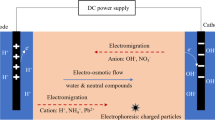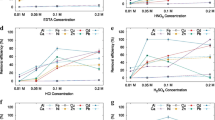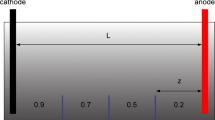Abstract
Soil pollution is a universal environmental issue, and the clean-up of contaminated soils can be costly and time consuming. Traditional methods often do not provide an effective solution when it comes to fine-grained and highly impermeable soils and/or immobile contaminants. Electro-remediation, however, is a promising technique. The aim of this study was to relate electrokinetic removal of heavy metals from a contaminated, aged sediment sludge to the metal speciation in the sludge. Metal speciation was determined by a Tessier-based sequential extraction method. Two electro-remediation experiments were conducted in the laboratory in order to investigate removal of metals. The studies were done in a cell designed for a predictive laboratory test of feasibility of electro-remediation of soil. Maximum removal percentages during the experiment using a constant current of 1 mA/cm2 over ∼180 h with a corresponding potential gradient of 0.5 V/cm were larger than 15 % for Cd (21 %), Cu (15 %), and Zn (23 %); Ni and Pb showed removal less than 10 %; Cr demonstrated no removal. Removal of non-contaminant metals Mn and Ca exceeded that of heavy metals. The removal rates were compared to metal speciation in the non-treated sludge, measured by the sequential extraction. It was observed that the electrokinetic removal did not directly relate to the metal distribution over the fractions within the sludge. The aging of metals and other geochemical characteristics of the contaminated sludge affected the removal of heavy metals. Therefore, sequential extraction alone does not provide a predictive tool for the effectiveness of electro-remediation. Additional geochemical information is needed.









Similar content being viewed by others
References
Acar, Y. B., & Alshawabkeh, A. N. (1993). Principles of electrokinetic remediation. Environmental Science & Technology, 27, 2638–2647.
Al-Hamdan, A. Z., & Reddy, K. R. (2008). Transient behavior of heavy metals in soils during electrokinetic remediation. Chemosphere, 71, 860–871.
Alshawabkeh, A. N. (2009). Electrokinetic soil remediation: challenges and opportunities. Separation Science and Technology, 44, 2171–2187.
Buykx, S. E. J., Bleijenberg, M., van der Hoop, M. A. G. T., & Loch, J. P. G. (2000). The effect of oxidation and acidification on the speciation of heavy metals in sulfide-rich freshwater sediments using a sequential extraction procedure. Journal of Environmental Monitoring, 2, 23–27.
Eick, M. J., Naprstek, B. R., & Brady, P. V. (2001). Kinetics of Ni(II) sorption and desorption on Kaolinite: residence time effects. Soil Science, 166, 11–17.
Ford, R. G., Bertsch, P. M., & Farley, K. J. (1997). Changes in transition and heavy metal partitioning during hydrous iron oxide aging. Environmental Science and Technology, 31, 2028–2033.
Hicks, R. E., & Tondorf, S. (1994). Electrorestoration of metal-contaminated soils. Environmental Science and Technology, 28, 2203–2210.
Lageman, R. (1993). Electroreclamation. Application in The Netherlands. Environmental Science and Technology, 27, 2648–2650.
Lageman, R., & Pool, W. (2009). Experiences with field applications of electrokinetic remediation. In K. R. Reddy & C. Cameselle (Eds.), Electrochemical remediation technologies for polluted soils, sediments and groundwater (pp. 697–717). Hoboken: Wiley.
Lima, A. T., Ottosen, L. M., Ribeiro, A. B., & Hansen, H. K. (2008). Electrodialytic removal of Cd from straw ash in a pilot plant. Journal Environmental Science and Health Part A: Environmental Science and Engineering, 43, 844–851.
Lima, A. T., Kleingeld, P. J., Heister, K., & Loch, J. P. G. (2011). In situ electro-osmotic cleanup of tar contaminated soil—removal of PAHs. Electrochimica Acta, 86, 142–147.
Ma, Y., Lombi, E., Oliver, I. W., Nolan, A. L., & McLaughlin, M. J. (2006). Long-term aging of copper added to soils. Environmental Science and Technology, 40, 6310–6317.
Maini, G., Shannan, A. K., Knowles, C. J., Sunderland, G., & Jackman, S. A. (2000). Electrokinetic remediation of metals and organics from historically contaminated soil. Journal of Chemical Technology and Biotechnology, 75, 657–664.
Nachtegaal, M., & Sparks, D. L. (2003). Nickel sequestration in a Kaolinite–Humic acid complex. Environmental Science and Technology, 37, 529–534.
Oonnittan, A., Sillanpaa, M., Cameselle, C., & Reddy, K. R. (2009). Field applications of electrokinetic remediation of soils contaminated with heavy metals. In K. R. Reddy & C. Cameselle (Eds.), Electrochemical remediation technologies for polluted soils, sediments and groundwater (pp. 609–624). Hoboken: Wiley.
Oorts, K., Bronckaers, H., & Smolders, E. (2006). Discrepancy of the microbial response to elevated copper between freshly spiked and long-term contaminated soils. Environmental Toxicology and Chemistry, 25, 845–853.
Ottosen, L. M., Hansen, H. K., & Jensen, P. E. (2009). Electrokinetic removal of heavy metals. In K. R. Reddy & C. Cameselle (Eds.), Electrochemical remediation technologies for polluted soils, sediments and groundwater (pp. 97–126). Hoboken: Wiley.
Page, M. M., & Page, C. L. (2002). Electroremediation of contaminated soils. Journal of Environmental Engineering, 128, 208–219.
Reddy, K. R., Parupudi, U. S., Devulapalli, S. N., & Xu, C. Y. (1997). Effects of soil composition on the removal of chromium by electrokinetics. Journal of Hazardous Materials, 55, 135–158.
Reddy, K. R., & Chinthamreddy, S. (2003). Effects of initial form of chromium on electrokinetic remediation in clays. Advances in Environmental Research, 7, 353–365.
Sposito, G. (2008). The chemistry of soils (2nd ed.). New York, NY: Oxford University Press.
Suèr, P., Gitye, K., & Allard, B. (2003). Speciation and transport of heavy metals and macroelements during electroremediation. Environmental Science and Technology, 37, 177–181.
Tessier, A., Campbell, P. G. C., & Bisson, M. (1979). Sequential extraction procedure for the speciation of particulate trace metals. Analytical Chemistry, 51, 844–851.
van der Perk, M. (2006). Soil and water contamination: from molecular to catchment scale. Leiden: Taylor & Francis-Balkema.
van Reeuwijk, L. P. (2002). Procedures for soil analysis. Technical Paper 9. International Soil Reference and Information Centre: Wageningen.
Yeung, A. T. (2011). Milestone developments, myths, and future directions of electrokinetic remediation. Separation and Purification Technology, 79, 124–132.
Yeung, A. T., Hsu, C., & Menon, R. M. (1997). Physicochemical soil-contaminant interactions during electrokinetic extraction. Journal of Hazardous Materials, 55, 221–237.
Author information
Authors and Affiliations
Corresponding author
Rights and permissions
About this article
Cite this article
Merkx, O.K., Loch, J.P.G., Lima, A.T. et al. The Effectiveness of Electro-Remediation of Aged, Metal-Contaminated Sediment in Relation to Sequential Extraction of Metals. Water Air Soil Pollut 224, 1667 (2013). https://doi.org/10.1007/s11270-013-1667-1
Received:
Accepted:
Published:
DOI: https://doi.org/10.1007/s11270-013-1667-1




